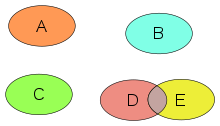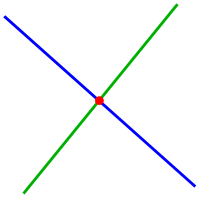Intersection



In mathematics, the intersection of two or more objects is another object consisting of everything that is contained in all of the objects simultaneously. For example, in Euclidean geometry, when two lines in a plane are not parallel, their intersection is the point at which they meet. More generally, in set theory, the intersection of sets is defined to be the set of elements which belong to all of them. Unlike the Euclidean definition, this does not presume that the objects under consideration lie in a common space. It simply means the overlapping area of two or more objects or geometries.
Intersection is one of the basic concepts of geometry. An intersection can have various geometric shapes, but a point is the most common in a plane geometry. Incidence geometry defines an intersection (usually, of flats) as an object of lower dimension that is incident to each of the original objects. In this approach an intersection can be sometimes undefined, such as for parallel lines. In both the cases the concept of intersection relies on logical conjunction. Algebraic geometry defines intersections in its own way with intersection theory.
Uniqueness[clarification needed]
There can be more than one primitive object, such as points (pictured above), that form an intersection. The intersection can be viewed collectively as all of the shared objects (i.e., the intersection operation results in a set, possibly empty), or as several intersection objects (possibly zero).
In set theory

The intersection of two sets A and B is the set of elements which are in both A and B. Formally,
- .[1]
For example, if and , then . A more elaborate example (involving infinite sets) is:
As another example, the number 5 is not contained in the intersection of the set of prime numbers {2, 3, 5, 7, 11, …} and the set of even numbers {2, 4, 6, 8, 10, …} , because although 5 is a prime number, it is not even. In fact, the number 2 is the only number in the intersection of these two sets. In this case, the intersection has mathematical meaning: the number 2 is the only even prime number.
In geometry

In geometry, an intersection is a point, line, or curve common to two or more objects (such as lines, curves, planes, and surfaces). The simplest case in Euclidean geometry is the line–line intersection between two distinct lines, which either is one point (sometimes called a vertex) or does not exist (if the lines are parallel). Other types of geometric intersection include:
- Line–plane intersection
- Line–sphere intersection
- Intersection of a polyhedron with a line
- Line segment intersection
- Intersection curve
Notation
Intersection is denoted by the U+2229 ∩ INTERSECTION from Unicode Mathematical Operators.
The symbol U+2229 ∩ INTERSECTION was first used by Hermann Grassmann in Die Ausdehnungslehre von 1844 as general operation symbol, not specialized for intersection. From there, it was used by Giuseppe Peano (1858–1932) for intersection, in 1888 in Calcolo geometrico secondo l'Ausdehnungslehre di H. Grassmann.[2][3]
Peano also created the large symbols for general intersection and union of more than two classes in his 1908 book Formulario mathematico.[4][5]
See also
- Constructive solid geometry, Boolean Intersection is one of the ways of combining 2D/3D shapes
- Dimensionally Extended 9-Intersection Model
- Meet (lattice theory)
- Intersection (set theory)
- Union (set theory)
References
- ^ Vereshchagin, Nikolai Konstantinovich; Shen, Alexander (2002-01-01). Basic Set Theory. American Mathematical Soc. ISBN 9780821827314.
- ^ Peano, Giuseppe (1888-01-01). Calcolo geometrico secondo l'Ausdehnungslehre di H. Grassmann: preceduto dalle operazioni della logica deduttiva (in Italian). Torino: Fratelli Bocca.
- ^ Cajori, Florian (2007-01-01). A History of Mathematical Notations. Torino: Cosimo, Inc. ISBN 9781602067141.
- ^ Peano, Giuseppe (1908-01-01). Formulario mathematico, tomo V (in Italian). Torino: Edizione cremonese (Facsimile-Reprint at Rome, 1960). p. 82. OCLC 23485397.
- ^ Earliest Uses of Symbols of Set Theory and Logic







